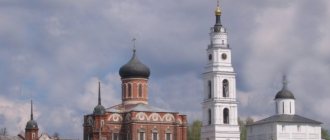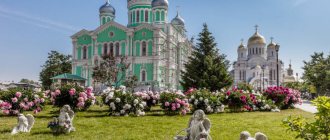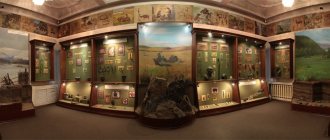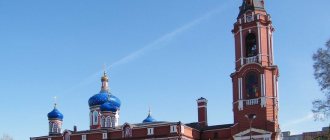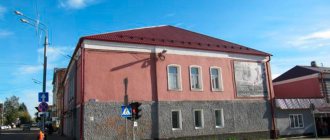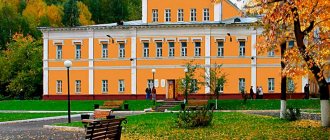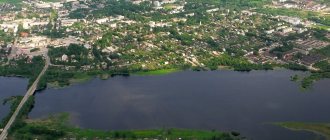Content
- 1 Transfiguration Cathedral (Uglich)
- 2 Church of the Nativity of John the Baptist (Uglich)
- 3 Church of Tsarevich Dimitri “on the Blood” (Uglich)
- 4 Church of Tsarevich Dimitri “on the field” (Uglich)
- 5 Temple of the Kazan Icon of the Mother of God (Uglich)
- 6 Temple of the Korsun Icon of the Mother of God (Uglich)
- 7 Temple of Florus and Lavra (Uglich)
- 8 Epiphany Cathedral of the Uglich Kremlin
- 9 Chapel of St. Alexander Nevsky (Uglich)
- 10 Chapel of Anastasia the Pattern Maker and Seraphim of Uglich (Uglich)
Beautiful church with tiles on the banks of the Volga
Church of the Nativity of John the Baptist
The ancient five-domed Church of the Nativity of John the Baptist
considered the most beautiful in the city. Travelers who sail to Uglich by river cannot take their eyes off it. The slender building on the basement seems to float above the ground. The golden walls are decorated with multi-colored tiles, and the bell tower is decorated with elegant stucco.
In the current church, three chapels have been consecrated. Divine services are rarely held here, so tourists cannot get inside and only admire the patterned facades.
Spaso-Preobrazhensky Cathedral (Uglich)[edit]
The Spaso-Preobrazhensky Cathedral of the Uglich Kremlin stands on the very bank of the Volga and is the main temple of Uglich. According to legend, sometime in the late 10th and early 11th centuries. Prince of Rostov Boris Vladimirovich, built a cathedral wooden church of Constantine and Helena with a chapel in honor of the Praise of the Virgin Mary in Uglich. In the first half of the 13th century. Next to this church, the Transfiguration Cathedral was erected, which became the main temple of the city, and the Church of Constantinople was assigned to it for a long time.
The Transfiguration Cathedral was initially made of wood. In 1485-1487 it was rebuilt in stone. It became part of the complex of the previously built princely palace. The temple was located to the west of the Chambers. The cathedral had one dome and stood on four pillars. He climbed up the basement. It was surrounded on three sides by a gallery.
Address:
Russia, Yaroslavl region, Uglich, Kremlin, 5
Shrines of the Uglich Kremlin
Spaso-Preobrazhensky Cathedral in the Uglich Kremlin
The central place in the architectural ensemble of the Kremlin is occupied by the cathedral church of the local diocese. Transfiguration Cathedral
has a long history. The very first church on the Volga bank stood from the second half of the 15th century. The building, which has survived to this day, was built in the 1710s by the serf masters of Prince Golitsyn and the architect Grigory Fedorov in the traditions of the Yaroslavl school and the “Naryshkin” baroque.
Epiphany Church in the Uglich Kremlin
Architecture lovers come to the Uglich Kremlin
to enjoy the simple forms and monumentality of the Transfiguration Cathedral. Inside there is a spacious hall for worshipers 14 m by 14 m and a magnificent six-tiered iconostasis.
Not far from the five-domed temple there is an elongated building with white and yellow tones, made in the traditions of classicism. The Church of the Epiphany was a winter church. Services were held here during the cold season, when the summer cathedral was closed. Nowadays, paintings and applied art of the 17th-19th centuries are exhibited in the spacious temple, and temporary exhibitions are held.
Bell tower in the Uglich Kremlin
To the south of the Transfiguration Cathedral rises a slender bell tower, which is clearly visible from the Volga and from the outskirts of the city. The 37 m high tower was erected in 1730. The first clock mechanism in the bell tower was installed in the 19th century, and in the 1980s it was replaced with a new one.
Church of the Nativity of John the Baptist (Uglich)[edit]
One of the most beautiful churches in Uglich stands next to the Resurrection Monastery, on the very bank of the Volga.
In 1663, at the wooden church that stood on this site, the murdered youth Ivan Chepolosov was buried. After 26 years, they began to build a stone church, they got to the bottom of the boy’s coffin: “his body was intact and incorruptible, and his clothes did not decay, even the coffin was new, and a great fragrance came out.” The current temple was built by his father in 1691 and the relics of his son were placed in it.
The stone temple was built in 1689-1690.
In 1941 the church was closed. In the 1970s, the church was restored according to the design of the architect S.E. Novikova.
Today the temple was returned to the believers and assigned to the nearby Resurrection Monastery.
Monastery of Russian princes
The age of Uglich has confidently crossed the thousand-year mark. Founded, according to various sources, in the 10th-11th centuries, it served as the residence of Russian princes and also performed a defensive function. Being a border city between the Moscow and Tver principalities, it was repeatedly attacked not only by alien conquerors, but by its own Russian troops directed by the warring princes.
It is impossible to count how many times Uglich burned. How many times was it restored and rebuilt from scratch - too. The last major fire here occurred with the establishment of Soviet power. The temple, church, Orthodox city was not to the liking of the Bolsheviks, who deliberately set it on fire in different parts. Eyewitnesses claimed that that fire turned into a sea of fire, in which the historical center of the city actually died.
Therefore, most of the buildings of the Middle Ages, built of wood, have not survived to this day. Only those built of stone survived, many on the site of those destroyed by fires in the distant Middle Ages. But the preserved diversity is enough to immerse yourself in the history and culture of the Russian people, enjoy the beauty of temple architecture, stroll leisurely along the banks of the Volga, watching how elegant churches and monasteries replace each other one after another.
Fact . Historians associate the name of the city with its location. Uglich stands on the “bend” of the Volga - in the place where the river bed forms a “corner”. In the old days, people used this natural “signpost” to navigate their way to Yaroslavl. Another version connects the name with coal mines: it is believed that black fuel has long been mined in the suburbs.
pixabay.com/
Church of Tsarevich Dimitri “on the Blood” (Uglich)[edit]
The Church of St. Tsarevich Demetrius is the most famous temple in Uglich. It stands on a high cape at the confluence of the Kamenny Stream and the Volga. This temple is mentioned in all guidebooks to the Golden Ring and the Volga, it has been visited by millions of people: pilgrims and tourists.
After the death of Tsarevich Dimitri on May 15, 1591, a chapel was built in the backyard of the princely palace. But it did not last long, until the time of the destruction of Uglich by the Poles. Then, in 1630, a tented wooden church in honor of Tsarevich Dimitri appeared on this site, and with it - the winter church of the Archangel Michael.
In the altar of the original temple there was a tomb, under which was the place where the prince’s blood was shed. According to legend, on every anniversary of death, blood appeared on the sand. Tsar Alexei Mikhailovich himself could observe this when he visited Uglich in 1663. Amazed by what he saw, he donated a cross to the church for the temple icon.
The stone church on the site of the old wooden one was built in 1692, the lower floor was occupied by the Church of the Archangel Michael, the upper floor was occupied by the Church of Tsarevich Demetrius. The temple was decorated in the Moscow picturesque style of that time. The main volume of the building rises on the basement and consists of four parts: the temple part, the altar, the porch with the bell tower and the refectory.
Address:
Yaroslavl region, Uglich, Kremlin, no. 3.
Sights in the vicinity of Uglich
Uglichskaya HPP
Uglichskaya HPP
The Uglich hydroelectric power station is located on the Volga River. It is part of the Volga-Kama cascade of hydroelectric power stations. This building is considered the oldest in all of Russia. It was launched in 1940. During the Second World War, it was the Uglich hydroelectric station that supplied water to Moscow.
This is not just a hydraulic complex, but a cultural heritage. The hydroelectric power station has facades and interiors that were designed by an architectural studio.
The power plant is currently being reborn. Soon RusHydro is going to completely update all equipment.
Address: Uglich, Yaroslavl region; GPS: 57.52443, 38.3007
Oryol Lake
Oryol Lake
The lake will win the heart of any tourist with its incredible beauty. It is best to come here in the evening when the sunset changes the color of the water. The shore is perfect for having a picnic and enjoying the scenery.
The only drawback of this place is that you cannot swim. But you can enjoy its beauty. The lake makes for beautiful and unique photographs.
Address: Orlovskoe lake, Yaroslavl region; GPS: 57.78652, 38.60424
Semendyaevo village
Semendyaevo village
An ancient village, which is located on the road to Kalyazin-Uglich. Almost nothing has changed there since its construction. Historical buildings, ancient residential buildings, public buildings, the Church of the Epiphany - all this can be seen there.
Having visited the village, it may seem that we have been transported straight to the last century. There is nothing modern there, only the life of people of the 20th century, which you can get to know better by visiting a historical monument.
Address: Semendyaevo, Yaroslavl region; GPS: 57.36154, 40.20168
Nikolo-Uleyma Monastery in the village of Uleyma
Nikolo-Uleyma Monastery in the village of Uleyma
Nikolo-Uleyminsky Monastery is a convent, which is located 11 kilometers from Uglich. It was built in 1406. It is the only remaining monastic ensemble and monastic complex of the Russian Orthodox Free Church.
The monastery is located in a picturesque location that complements the architecture of the temple. There are no restrictions for tourists on the territory; you can visit any place.
Address: pos. Uleyma, Yaroslavl region; GPS: 57.43885, 38.41071
Ethnographic Museum of the Katskari in the village of Martynovo
Ethnographic Museum of the Katskari in the village of Martynovo
The ethnographic museum includes many peasant huts. They were built in the 19th and 20th centuries. The main exhibit is the house, which was built in 1910. Its area is 177.7 square meters. Visitors can go everywhere and see everything. A large number of ancient household items have been preserved here. Each hut has been preserved the same as it was many years ago.
Also, in addition to interesting historical exhibits, here you can get to know the local inhabitants of the farmstead - goats, geese, sheep, chickens. The place will be interesting for both adults and children.
Address: Martynovo, Yaroslavl region; GPS: 57.67793, 37.99397
Church of Tsarevich Dimitri “on the field” (Uglich)[edit]
On the field, where the people of Uglich stopped the procession with the body of the prince and said goodbye to him, first a chapel was erected, then a wooden church, and in 1800 - the current one, “On the field” or “In the cemetery”. This is the only functioning temple that the Soviet government left to the people.
Here are kept: the relics of the blessed prince Roman of Uglich, a particle of the relics of Tsarevich Dimitri, the caftan of Tsarevich Dimitri, the Feodorovskaya icon of the Mother of God, before which Tsarevich Dimitri prayed, the Athonite icon of the Mother of God, the icon of the Intercession of the Mother of God, which appeared in the 14th century. (the same icon is kept in the History and Art Museum, which of them is a list is unknown) and other shrines. Until recently, bloody nuts, taken from the hand of the murdered prince, lay openly, but they were stolen.
On the day of the murder of Tsarevich Dimitri - May 15 (28) - there is a religious procession from the temple to the Kremlin. Local authorities promote this holiday as a children's holiday.
Address:
st. Rostovskaya, 66
Telephone:
+7(48532) 2-22-67
Best hotels in Uglich
Related materials:
- 33 attractions of Bakhchisaray that are worth visiting
- 36 Izmir attractions recommended for…
- 24 must-see attractions in Cappadocia
- 30 Larnaca attractions recommended for…
- 40 attractions in Limassol that are worth seeing
- 31 attractions of Novorossiysk to visit
- 25 sights of Olenevka that are worth seeing
- 28 best Ivanovo attractions that…
- 34 best sights of Vologda that…
Did you like the article? Share with friends:
Temple of the Kazan Icon of the Mother of God (Uglich)[edit]
The Church of the Kazan Icon of the Mother of God was built at the end of the 18th century in the Baroque style. The temple building is two-story, all directed upward, like a candle. The tall and slender main part is oriented vertically; not only does it end with two tall narrow eights and a small head on a very high and thin drum; in addition, the quadrangle windows are also high and narrow, and their Baroque-style platbands only emphasize this. The refectory, usually long, is made short here, also two-story and high, so it does not disturb the harmony of the building. A large three-tier bell tower in the classicist style rises above the head of the temple. It was added to the church later, after the fire of 1793.
Address
: Russia, Yaroslavl region, Uglich city, Uspenskaya square, 7
Telephone:
+7(910)811 33 53
Email:
Where to go in Uglich on the second day and what to see with children
A busy first day will make your legs ache, but in this small, at first glance, city, there are still many objects worthy of your attention. What are the exhibitions of 15 city museums worth? It’s definitely worth spending the whole day to get to know them in detail.
On Spasskaya Street, in the very center of the city, there is the house-museum “Legends of Uglich”. It is definitely worth a visit if you are deciding what to see in Uglich with children. The museum's exhibition is small, but very interesting. “Wonders of technology” from the beginning of the last century are exhibited here: cameras, a piano, a gramophone. And you can even call the first landline telephone, which once belonged to the owner of the estate, and is now on display in the museum.
Children will also be interested in museums of dolls and bicycles. They are located in neighboring buildings, so they traditionally visit them together. The doll museum features smartly dressed “boys and girls,” literary characters and well-recognized cartoon animals. It is customary to look at the exhibits with attention, and buy a souvenir in the museum shop - their selection will please even the most experienced tourist.
wikipedia.org/Borisz51/CC BY-SA 3.0
The bicycle museum is dedicated to popular eco-friendly transportation from the early days to the present day. Here you can see both exhibits that are quite familiar to the modern eye, as well as unusual bicycles that are no longer produced today. Some of the exhibits can be tested - ride on the site in front of the museum, and some - rented in order to have time to explore as many interesting places in the city as possible.
In the same building where the bicycles are displayed, the Whistle Museum is “hidden”. Children adore it, as there is a pottery workshop at the museum. And every little guest can try to make a clay vessel or even a musical instrument, and then paint it with their own hands.
Another museum in the neighborhood is prison art. Why exactly in Uglich they decided to create such a characteristic exhibition is unknown. But guests of the city like the “forbidden zone”: here you can see unsightly but soulfully made musical instruments, checkers and backgammon, paintings on sheets and even figurines made from bread crumbs. All the creators either served time in prison at one time or are still there.
Uglich is the only city in Russia where there is a Vodka Museum. It owes its creation to Russian entrepreneur Pyotr Smirnov , founder of the world famous brand of alcoholic drink, nicknamed the “vodka king”. Pyotr Smirnov was originally from these places, and today there is an exhibition in Uglich that is open all year round. It presents not only samples of products from different times, but also moonshine stills, bottling equipment, antique vessels and bottles, and even a medal weighing almost 7 kg, which Tsar Peter I, the eternal fighter against drunkenness, once awarded to those who especially distinguished themselves. the drunken business of the courtiers.
In Uglich there are also museums of myths and superstitions, a working horse, and leather craftsmanship. Without exception, everyone works during the tourist season, which falls on the May holidays and summer months. Therefore, there are no problems with what to see in Uglich in summer: when tourists arrive, the town comes to life and hospitably opens the doors of exhibitions for every taste.
wikipedia.org / Public domain
Temple of the Korsun Icon of the Mother of God (Uglich)[edit]
The Temple of the Korsun Icon of the Mother of God was built in 1730. The central altar was consecrated in honor of the Korsun icon, the chapel in honor of St. Macarius of Egypt, in memory of the former monastery.
In 1942 the temple was closed. In 1972, restoration was carried out under the leadership of the leading restorer of the Yaroslavl region S.E. Novikov.
Divine services resumed on May 1, 1994.
In 1996, with the blessing of Archbishop Micah, the relics of the martyr John Chepolosov were brought to the temple, in 2002. The Korsun temple icon of the Mother of God was given to the church.
Address
: Russia, Yaroslavl region, Uglich city, Narimanov street, 5a
Telephone:
+7(48532)502 81
Email:
Chapel of St. Alexander Nevsky (Uglich)[edit]
Next to the Kazan Church, near the half-overgrown defensive Kremlin moat, stands the dark tent of the new city chapel in the name of Alexander Nevsky.
It was built in 2004 as a monument to the Uglich residents who died in all wars defending their Fatherland.
The chapel is octagonal, tented, lined with black and red granite, completed with a copper dome on four columns and an openwork cross. The lower part has a profiled base and arched niches completed with pediments. The entrance to the chapel is from the south. Inside, in arched niches, there are mosaic icons of Alexander Nevsky, St. George the Victorious and Archangel Michael. The chapel is surrounded by a platform with flower beds, stairs and retaining walls.
Address:
Yaroslavl region, Uglich, Uspenskaya square
What to bring from Uglich as a gift
The special character of the city requires special souvenirs. Therefore, you can find interesting things in the numerous sales tents located at the entrance to Victory Park. For example, handmade jewelry - earrings, beads and rings. As in most old Russian cities, folk crafts and crafts are preserved in Uglich, and therefore handmade products here are original and distinctive. You can buy linen clothes as a gift: of course, you won’t be able to wear them - shirts and sundresses are made in folk style. But as a gift, bring an outfit from the colorful Uglich - why not?
During Soviet times, the town was famous as a watch production center. Here was the famous one, whose products were valued not only in the Union, but also abroad. Today, the scale of production is no longer the same, and even “Zvezda”, but the products are still sold. If you are looking for a special Uglich souvenir, a watch may be a good choice.
There is another souvenir market located on Yaroslavl Square. There you can find knitted and fur items, paintings by local artists and textiles. Don't forget to stop by the Doll Museum and pick up a souvenir there. Gastronomic souvenirs are also traditionally brought from Uglich. Local cheeses, organic dairy products and mineral water have earned fame far beyond the Golden Ring of Russia.
